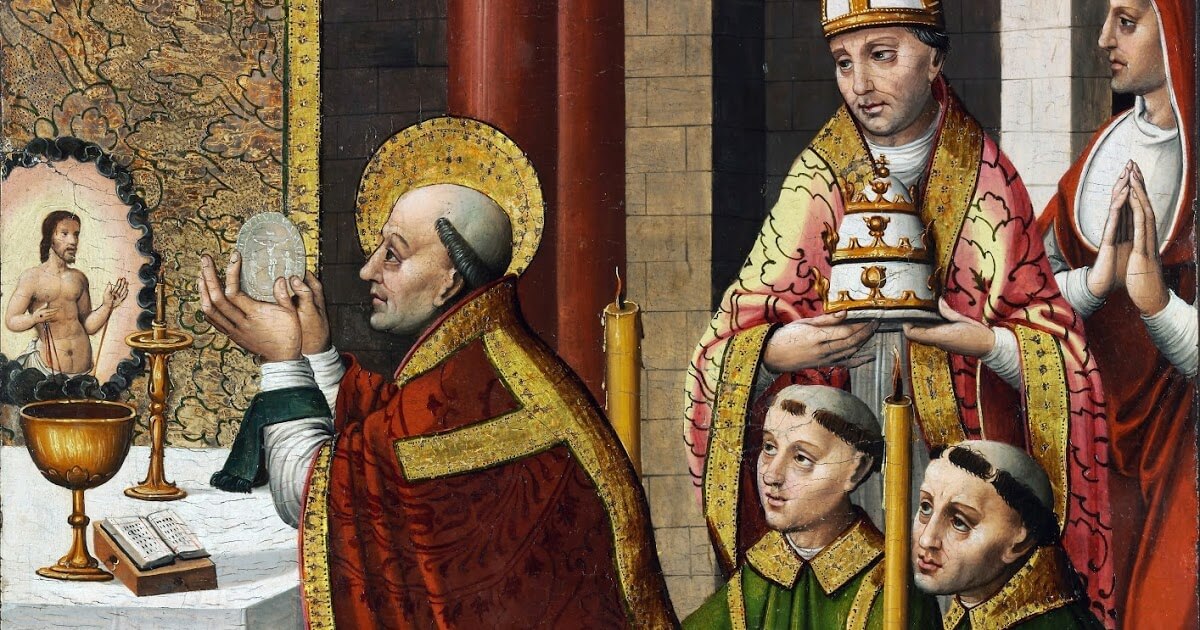Mass of Saint Gregory the Great by Master of Portillo (1520-1525).
Far too often these days liturgical discussions pertaining to the Roman Rite start with the popular myth that the Traditional Latin Mass only dates back to the sixteenth century and the Council of Trent (1545-1563). While some make this claim simply due to a lack of catechesis, there are unfortunately others who perpetuate the myth to diminish the very antiquity of the ancient rite. Let us remedy this by busting the myth of the “Tridentine” Mass.
First a note on terminology. The Tridentine Mass is simply another name for the Traditional Latin Mass, also called the Extraordinary Form of the Roman Rite since Summorum Pontificum was issued by Pope Benedict XVI in 2007.
Now for the history. Following the Council of Trent, Pope St. Pius V issued the papal Bull Quo Primum regarding the Mass. It is important to note that Pius V did not promulgate a new Mass (as Paul VI did in 1970), but rather consolidated and codified the Roman Rite already in existence. He also extended its use throughout the Latin Church, granting exception only to those rites demonstrating continuous usage of more than 200 years, such as the Ambrosian Rite found in Milan.
Since the 1570 Missal of Pius V was issued in the wake of the Council of Trent, the ancient rite has often been referred to as the Tridentine Mass. While there is nothing inherently wrong with this term, it can (and has) been used by some seeking to diminish the ancient rite by implying that it only dates back to 1570.
This, of course, is a myth.
Writing 50 years before the Second Vatican Council (1962-1965) and the promulgation of the new Mass of Paul VI (1970), Father Adrian Fortescue discussed the very antiquity of the Roman Rite in his classic, The Mass: A Study of the Roman Liturgy (1912):
Essentially the Missal of St. Pius V is the Gregorian Sacramentary; that again is formed from the Gelasian book which depends on the Leonine collection. We find the prayers of our Canon in the treatise de Sacramentisand allusions to it in the IV century. So our Mass goes back, without essential change, to the age when it first developed out of the oldest liturgy of all. It is still redolent of that liturgy, of the days when Caesar ruled the world and thought he could stamp out the faith of Christ, when our fathers met together before dawn and sang a hymn to Christ as to a God. The final result of our enquiry is that, in spite of unsolved problems, in spite of later changes, there is not in Christendom another rite so venerable as ours.
And this of course is the point. Not that the Mass didn’t develop organically, because it had. Nor that there were no further revisions to it, since the Missal of 1962 used in the Extraordinary Form today incorporates (as one example) the Holy Week revisions of 1955. But rather, that the Traditional Mass dates back to the oldest liturgy of all “without essential change”, to use Fr. Fortescue’s phrase. When referencing this Mass, we are speaking in terms of millennia, not centuries.
Indeed, some have referred to the traditional liturgy as the Gregorian Rite, or the Gregorian Mass, in deference to the ancient sacramentary bearing the name of that sixth century saint; a pope and liturgy which preceded Trent by one thousand years.
As liturgical discussions move forward within the Church, and both forms of the Roman Rite are studied and considered, let us hope that (at a minimum) we can finally bust the myth that the Traditional Mass is a product of the 16th century. If we are truly to restore all that has been lost for so many, we must first begin with correct information and intellectual honesty.
Originally published at LiturgyGuy.com. Reprinted with permission.


